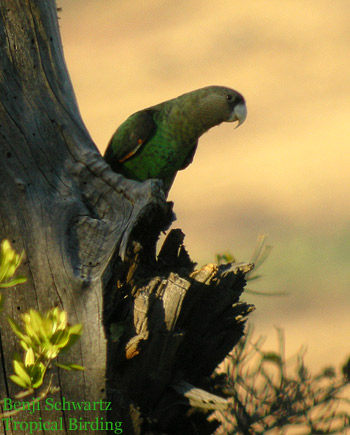- Poicephalus robustus
Identification
Yellowish-brown head (female has reddish-orange band on forehead). Mantle and upper wing coverts dark green with paler green edges. Flight feathers and tail is blackish. Orange-red wrists and leggings. Back, rump, upper tail coverts, and underparts blue-green.
Similar species
Brown-necked Parrot is not supposed to overlap in range. The closest birds in that species has a grey head and larger bill.
Distribution
This species is found in the south-east South Africa as well as in the Drakensberg range in Limpopo west of Kruger NP.
Taxonomy
This species was split from Brown-necked Parrot
This is a monotypic species[1].
Habitat
Forests in mountains and foothills especially where Podocarpus grows.
Behaviour
Usually in pairs or small groups; groups of up to 30 have been seen at rich food sources. Nomadic; may fly long distances (possibly more than 100 km) between forest patches depending on food availability. Feeds mainly on Yellowood (Podocarpus) endocarps; also nuts, seeds and fruit.
Breeding
Monogamous. Nests in a cavity in the trunk or branch of a tree (usually Yellowwood). Two to five eggs are laid (usually August to February) and incubated for 28-30 days by the female. The nestling period is 55-79 days, and young birds are probably dependant on the adults for more than a year.
Vocalisation
References
- Clements, J. F., T. S. Schulenberg, M. J. Iliff, S. M. Billerman, T. A. Fredericks, B. L. Sullivan, and C. L. Wood. 2019. The eBird/Clements Checklist of Birds of the World: v2019. Downloaded from http://www.birds.cornell.edu/clementschecklist/download/
- Gill F, D Donsker & P Rasmussen (Eds). 2021. IOC World Bird List (v11.1). doi : 10.14344/IOC.ML.11.1. http://www.worldbirdnames.org/
- Collar, N., P. F. D. Boesman, and G. M. Kirwan (2020). Cape Parrot (Poicephalus robustus), version 1.0. In Birds of the World (P. G. Rodewald, Editor). Cornell Lab of Ornithology, Ithaca, NY, USA. https://doi.org/10.2173/bow.bnnpar2.01
- Cape Parrot Working Group. 2006. Cape Parrot Fact File. Downloaded from www.cpwg.unp.ac.za on 23 September 2008.
Recommended Citation
- BirdForum Opus contributors. (2024) Cape Parrot. In: BirdForum, the forum for wild birds and birding. Retrieved 13 May 2024 from https://www.birdforum.net/opus/Cape_Parrot
External Links
GSearch checked for 2020 platform.





